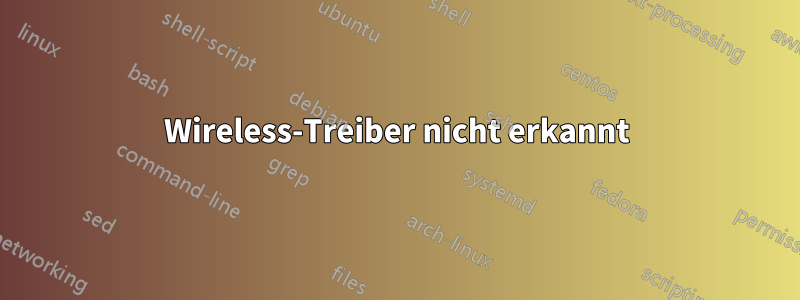
Wenn ich iwconfig eingebe, erhalte ich nur „keine drahtlosen Erweiterungen“
Wie kann ich erreichen, dass der Ubuntu-Wireless-Treiber erkannt wird?
lspci:
00:00.0 Host bridge: ATI Technologies Inc RS690 Host Bridge
00:01.0 PCI bridge: ATI Technologies Inc RS690 PCI to PCI Bridge (Internal gfx)
00:04.0 PCI bridge: ATI Technologies Inc Device 7914
00:05.0 PCI bridge: ATI Technologies Inc RS690 PCI to PCI Bridge (PCI Express Port 1)
00:06.0 PCI bridge: ATI Technologies Inc RS690 PCI to PCI Bridge (PCI Express Port 2)
00:12.0 SATA controller: ATI Technologies Inc SB600 Non-Raid-5 SATA
00:13.0 USB Controller: ATI Technologies Inc SB600 USB (OHCI0)
00:13.1 USB Controller: ATI Technologies Inc SB600 USB (OHCI1)
00:13.2 USB Controller: ATI Technologies Inc SB600 USB (OHCI2)
00:13.3 USB Controller: ATI Technologies Inc SB600 USB (OHCI3)
00:13.4 USB Controller: ATI Technologies Inc SB600 USB (OHCI4)
00:13.5 USB Controller: ATI Technologies Inc SB600 USB Controller (EHCI)
00:14.0 SMBus: ATI Technologies Inc SBx00 SMBus Controller (rev 14)
00:14.1 IDE interface: ATI Technologies Inc SB600 IDE
00:14.2 Audio device: ATI Technologies Inc SBx00 Azalia (Intel HDA)
00:14.3 ISA bridge: ATI Technologies Inc SB600 PCI to LPC Bridge
00:14.4 PCI bridge: ATI Technologies Inc SBx00 PCI to PCI Bridge
00:18.0 Host bridge: Advanced Micro Devices [AMD] K8 [Athlon64/Opteron] HyperTransport Technology Configuration
00:18.1 Host bridge: Advanced Micro Devices [AMD] K8 [Athlon64/Opteron] Address Map
00:18.2 Host bridge: Advanced Micro Devices [AMD] K8 [Athlon64/Opteron] DRAM Controller
00:18.3 Host bridge: Advanced Micro Devices [AMD] K8 [Athlon64/Opteron] Miscellaneous Control
01:05.0 VGA compatible controller: ATI Technologies Inc RS690M [Radeon X1200 Series]
02:04.0 CardBus bridge: Ricoh Co Ltd RL5c476 II (rev b6)
02:04.1 FireWire (IEEE 1394): Ricoh Co Ltd R5C832 IEEE 1394 Controller (rev 02)
10:00.0 Ethernet controller: Broadcom Corporation NetLink BCM5787M Gigabit Ethernet PCI Express (rev 02)
lsusb:
Bus 006 Device 001: ID 1d6b:0001 Linux Foundation 1.1 root hub
Bus 005 Device 001: ID 1d6b:0001 Linux Foundation 1.1 root hub
Bus 004 Device 002: ID 08ff:2580 AuthenTec, Inc. AES2501 Fingerprint Sensor
Bus 004 Device 001: ID 1d6b:0001 Linux Foundation 1.1 root hub
Bus 003 Device 001: ID 1d6b:0001 Linux Foundation 1.1 root hub
Bus 002 Device 004: ID 066f:8000 SigmaTel, Inc. MSCN MP3 Player
Bus 002 Device 002: ID 03f0:171d Hewlett-Packard Wireless (Bluetooth + WLAN) Interface [Integrated Module]
Bus 002 Device 001: ID 1d6b:0001 Linux Foundation 1.1 root hub
Bus 001 Device 001: ID 1d6b:0002 Linux Foundation 2.0 root hub
sudo lshw -class network:
*-network
description: Ethernet interface
product: NetLink BCM5787M Gigabit Ethernet PCI Express
vendor: Broadcom Corporation
physical id: 0
bus info: pci@0000:10:00.0
logical name: eth0
version: 02
serial: 00:1a:4b:82:59:ee
capacity: 1Gbit/s
width: 64 bits
clock: 33MHz
capabilities: pm vpd msi pciexpress bus_master cap_list ethernet physical tp 10bt 10bt-fd 100bt 100bt-fd 1000bt 1000bt-fd autonegotiation
configuration: autonegotiation=on broadcast=yes driver=tg3 driverversion=3.116 firmware=sb v2.09 latency=0 link=no multicast=yes port=twisted pair
resources: irq:43 memory:d0000000-d000ffff
/etc/Netzwerk/Schnittstellen:
auto lo
iface lo inet loopback
sudo rfkill list:
0: hci0: Bluetooth
Soft blocked: no
Hard blocked: no
1: hp-wifi: Wireless LAN
Soft blocked: yes
Hard blocked: no
2: hp-bluetooth: Bluetooth
Soft blocked: no
Hard blocked: no
Antwort1
Die Ausgabe sudo rfkill listzeigt, dass Ihre Netzwerkkarte „soft-blockiert“ ist.
Dies kann passieren, wenn der WLAN-Karte das Signal zum Ausschalten gegeben wurde – dies liegt wahrscheinlich an einem Schalter vom Typ Fn+.
Wenn Sie den Tastaturschalter nicht identifizieren können, führen Sie die folgenden Schritte aus:
Führen Sie es in einem Terminal aus:
sudo rfkill unblock hp-wifi; sudo rfkill unblock wifi; sudo rfkill unblock allFühren Sie den Vorgang erneut aus
sudo rfkill list, um zu bestätigen, dass die Karte entsperrt wurde.Neustart
Führen Sie den Vorgang
sudo rfkill listerneut aus, um zu bestätigen, dass die Entsperrung beibehalten wurde.erneut ausführen
sudo lshw -class network– Sie sollten jetzt sehen, ob der Kernel die WLAN-Karte erkannt hat (oder nicht).
Wenn das Wireless-Kernelmodul erkannt wurde (es sollte nicht „nicht beansprucht“ angezeigt werden), sollte Network Manager nun in der Lage sein, Wireless-Netzwerke zu sehen, die in Ihrer Nähe verfügbar sind.


